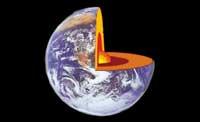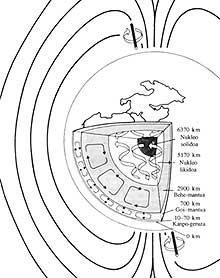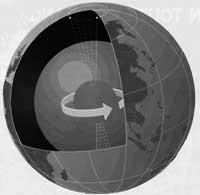The core of the Earth
1999/10/31 Kortabarria Olabarria, Beñardo - Elhuyar Zientzia
The new exploratory techniques that are being developed lately, such as the measurement of seismic waves, have helped to know a little about the interior of this ancient Earth, especially the surface and the mantle, while the core is still somewhat mysterious.

However, as for the knowledge of core characteristics, not everything is dark, there are lights. In fact, some phenomena, such as the Earth's magnetic field, depend on the shape, size, and composition of the core. Knowing the mass and volume of the earth, it was possible to calculate the mean density of the nucleus, approximately 5,500 kilograms per cubic meter. However, it should be noted that the more internal the matter is the more compressed, so, according to experts today, the density of the core can be around 12,000 kilograms per cubic meter. Therefore, from there you can think what characteristics you can have.
With this data - and others of a computer nature - it is possible to develop theories or models, but little more, since it is not possible to reach the interior of the Earth and know its characteristics. According to the most accepted theories and models, the terrestrial core would have a radius of 3,500 kilometers and the temperature would exceed 6,000 degrees Kelvin. The present matter would be an alloy of nickel and iron, due to the high density of both metals. In the 2,270 outer kilometers of this alloy the matter would be liquid, while in 1,200 interior would be solid.
Above the core is the mantle, located in the 2,900 kilometers following the ground radius. The temperature of the mantle, both inside and outside, would range from 3,800 to 1,300 degrees Kelvin. The mantle would consist of iron and magnesium rocks, with silicon and oxygen. The rock is solid, but due to the pressure can move and exit in liquid state the surface.
Finally, the earth's crust. The terrestrial surface has a depth of between 8 and 70 kilometers, variable as measured in oceans or continents. Here it is a solid matter, with rocks formed mainly by a lava that is directed from the inside towards the surface. These rocks are called basalts and consist of iron, aluminum and magnesium silicate. There are also granite rocks -potassium silicate, sodium and aluminium- that form the continents. The density of the mantle is higher than that of both types of rocks, so the terrestrial surface is continuously floating over the mantle.

From a general point of view it is observed that the high density elements are closer to the center of the Earth, while the low density ones are closer to the surface. This is important, as you can know that the core is rich in iron and that the mantle and the earth's crust are silicates. When the Earth was formed, the chemical compounds of the planet's nebula began to condense. As a result, in the giant sphere that emerged, it still had a uniform mixture of all compounds, but when gravity began to unfold and the planet began to contract, the indoor temperature increased. Radioactivity of some chemical elements also influenced. Then the matter was melted, the denser materials went inside and the rest were floating over them. The earth was an independent body.
As the core is metallic, the Earth has a powerful magnetic field. Iron, being an excellent conductor and almost liquid, has become a natural dynamo. In the most liquid part of the nucleus convection currents are generated, since when the material is raised it cools and when it comes down it heats up. These convection currents are those that, progressing slowly and in a very organized way, generate magnetic fields. The rotation movement of the planet also contributes to it.
Knowing this, it can be said that any planet with magnetic field in the solar system has a fluid core and rotating conductor. Mars, for example, has signs of magnetism. Therefore, one may think that in the past it had a living nucleus, although now it does not or has cooled too much.
As long as the Earth has a hot core, the matter of the mantle will continue to have convection movements. The interior of the mantle, in contact with the outside of the nucleus, produces most of the heat that can alter the appearance of the Earth's crust, either through plate tectonics -earthquakes, or through vulcanism. Vulcanism was also the cause of the atmosphere, although it was later transformed by living beings.
If one day the work of the Earth's core remains, the same will happen to our planet as to Mars. Volcanism will end, the continental movement will also, the magnetic field will disappear and with it the magnetosphere, which today protects us from the dangerous solar radiation, and the only phenomenon of nature to change the shape of the earth's surface will be erosion. Finally, the Earth will be an uninhabitable and dry planet.
Published in 7

Gai honi buruzko eduki gehiago
Elhuyarrek garatutako teknologia






